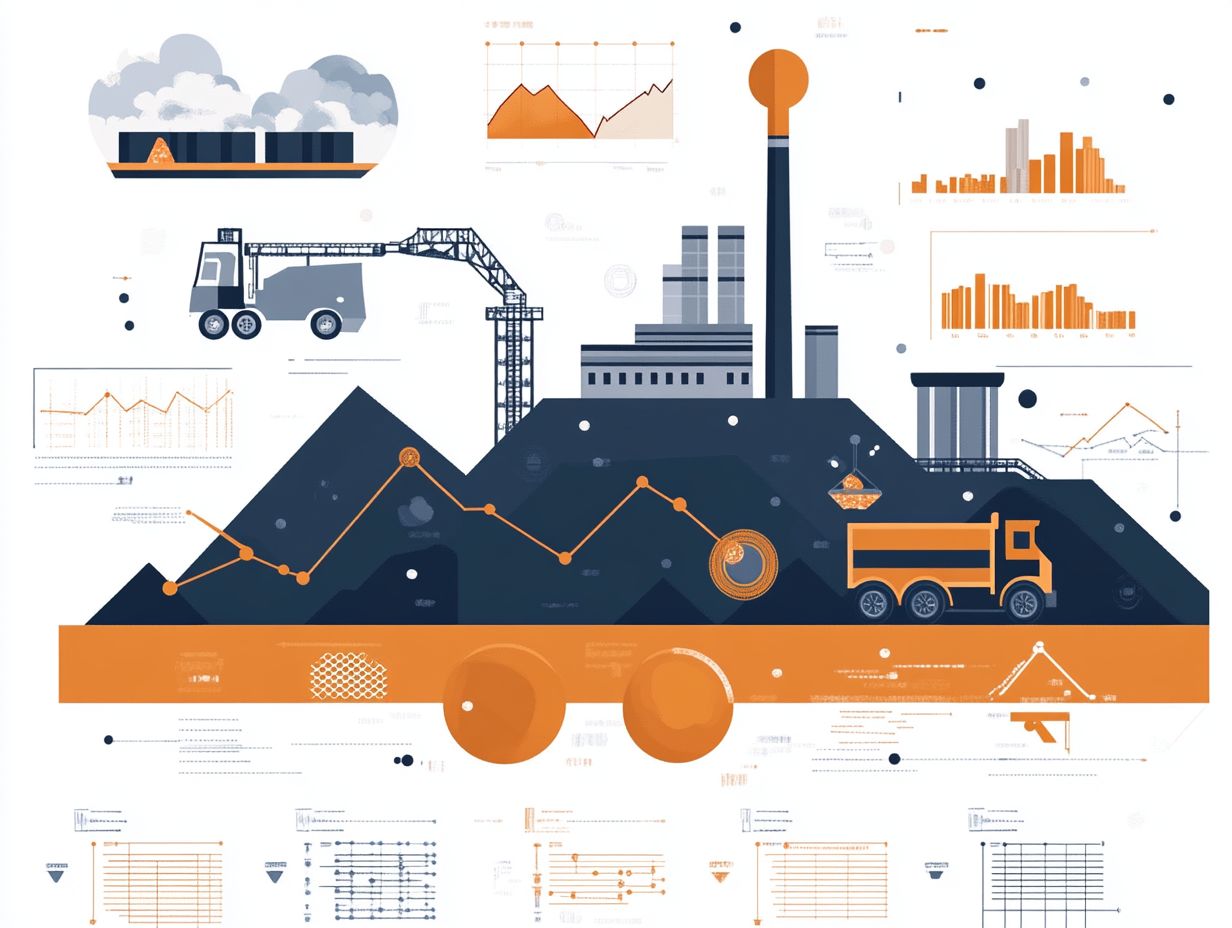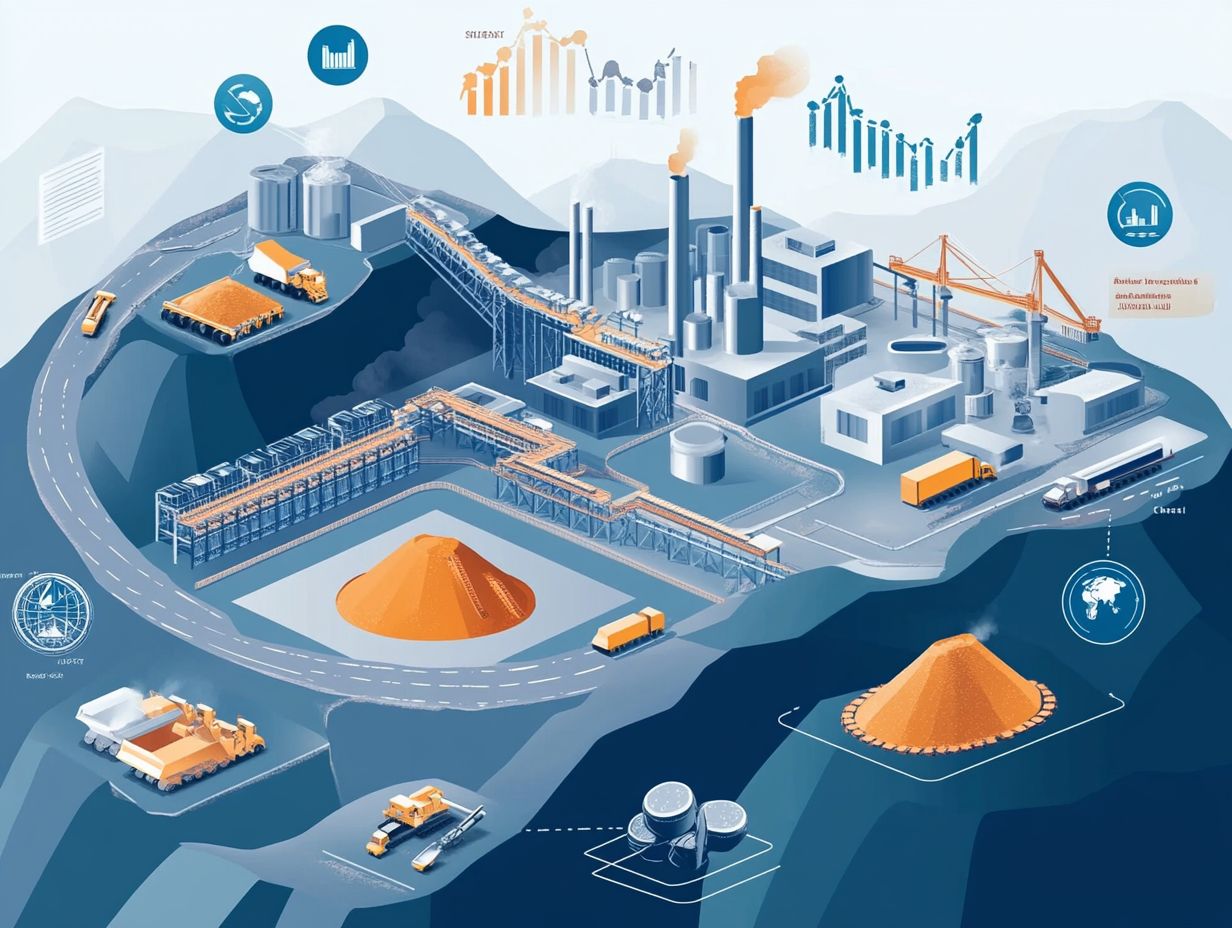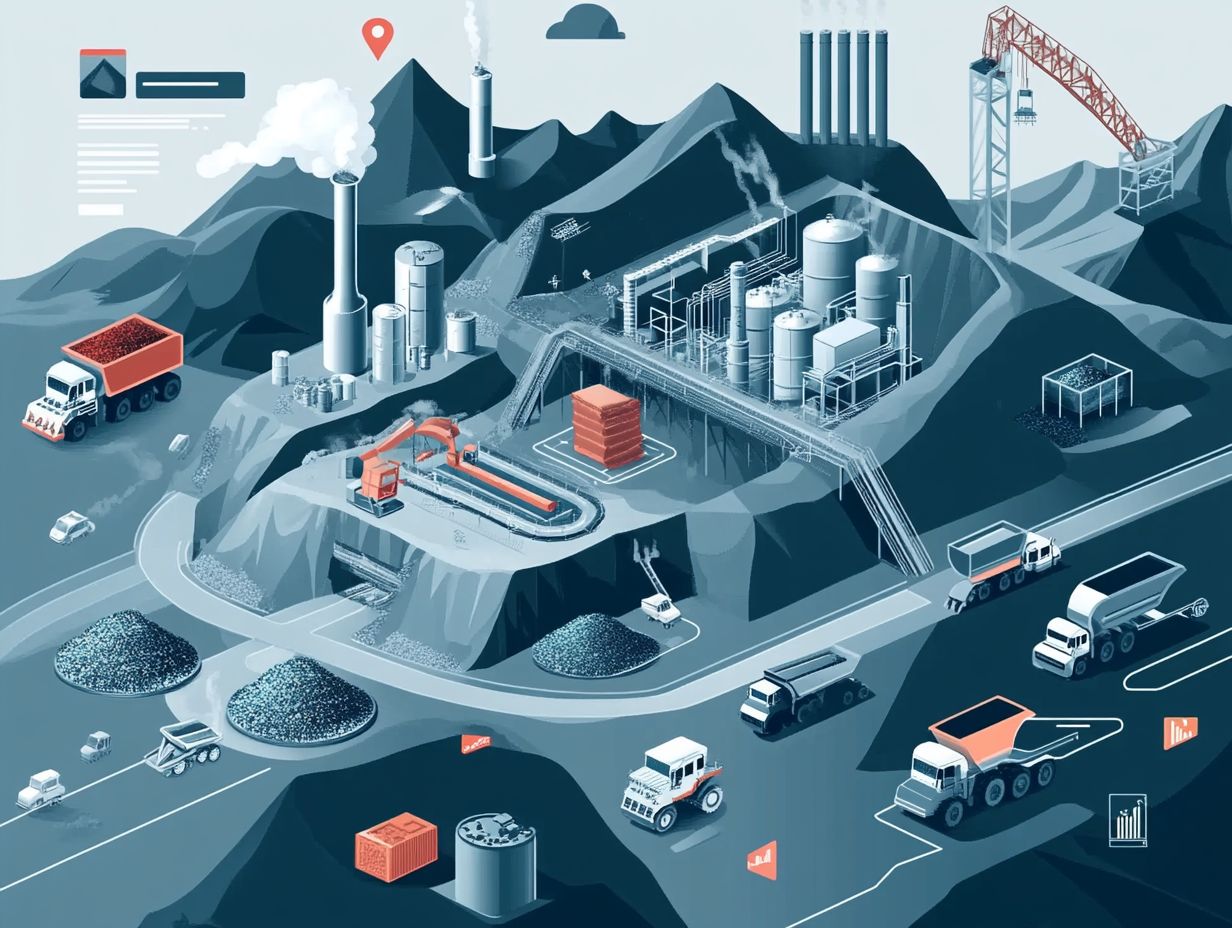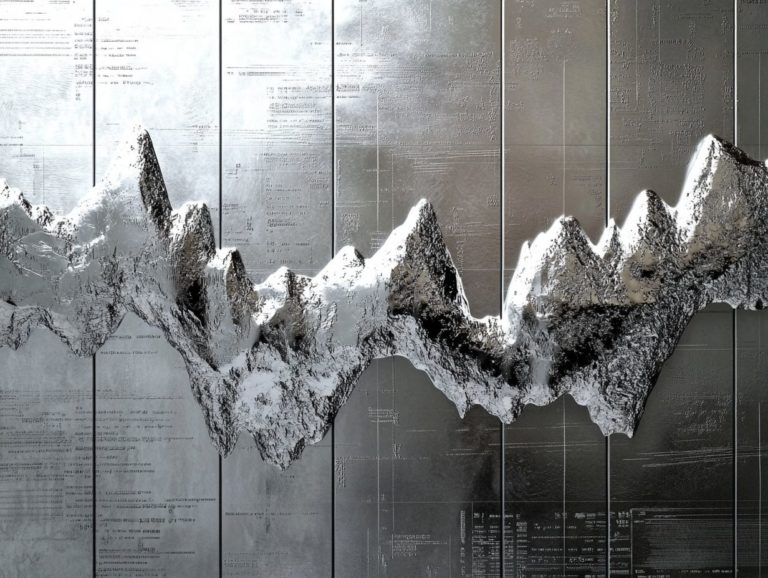Palladium Supply Chain: Trends and Risks
The palladium supply chain involves important players and steps that significantly influence global markets. As demand rises especially in the automotive and electronics sectors understanding trends is essential.
This flourishing market, however, faces challenges, including environmental concerns and geopolitical risks. You ll explore the dynamics of this supply chain, uncover emerging trends shaping its future, assess the associated risks, and examine initiatives designed to tackle these challenges.
Get ready to uncover what the future holds for the supply chain of this precious metal!
Contents
- Key Takeaways:
- Overview of the Palladium Supply Chain
- Trends in the Palladium Market
- Risks in the Palladium Supply Chain
- Efforts to Address Risks in the Supply Chain
- Future Outlook for the Palladium Supply Chain
- Frequently Asked Questions
- What is the current global supply trend for palladium?
- What are the main risks facing the palladium supply chain?
- How is the demand for palladium changing?
- What impact does recycling have on the palladium supply chain?
- What are the major trends in the palladium supply chain?
- How are market fluctuations affecting the palladium supply chain?
Key Takeaways:
- The palladium supply chain is complex and involves various key players and processes.
- The global demand for palladium is increasing while supply remains limited, leading to potential price volatility.
- Environmental and social concerns, as well as geopolitical risks, pose challenges, but industry initiatives and regulations are addressing them.
Overview of the Palladium Supply Chain
The palladium supply chain serves as a vital artery in the Global Palladium Market, profoundly influencing sectors like automotive and chemicals, particularly through its role in devices that reduce harmful emissions from vehicles.
As demand surges to unprecedented heights partly fueled by the electric vehicle boom it’s essential to grasp the intricacies of supply sources and market dynamics.
Primary supply largely comes from mining operations in South Africa and Russia, while secondary supply is enhanced by the recycling of catalytic converters.
The impact of COVID-19 revealed weaknesses in the supply chain, underscoring the need for thorough market analysis to navigate forthcoming challenges.
Key Players and Processes
Key players in the palladium supply chain include industry giants like Johnson Matthey, Nornickel, and Umicore. Each contributes unique processes that shape the competitive landscape.
These companies guide the journey from the initial extraction of palladium ore to its transformation into valuable products. For example, Johnson Matthey excels in refining and recycling precious metals, minimizing waste through advanced technologies. Additionally, exploring palladium investment opportunities in 2024 can provide insights into the market’s potential.
Nornickel, one of the largest producers globally, emphasizes mining while prioritizing sustainable practices to lessen environmental impact. Meanwhile, Umicore specializes in recycling, employing innovative methods to reclaim palladium from spent catalysts, thus promoting a circular economy. Additionally, understanding platinum demand and current trends can provide valuable insights into market dynamics.
Each entity adeptly navigates changing market conditions, adjusting production levels and forming strategic partnerships to maintain their competitive edge and ensure reliable supply amidst price fluctuations.
Trends in the Palladium Market
Current trends in the palladium market reveal notable shifts in both demand and supply, influenced mainly by the automotive industry’s pivot toward electric vehicles and rising environmental regulations in the chemical sector.
These changes create a dynamic landscape that requires your attention to effectively navigate the evolving market.
Global Demand and Supply

Global demand and supply dynamics for palladium are increasingly shaped by price volatility, geopolitical tensions, and pivotal policies in key markets like China.
These intertwined factors create a complex web that can significantly influence production outputs and consumer consumption patterns. As geopolitical tensions rise whether from trade disputes or military conflicts the ensuing uncertainty can prompt sudden shifts in investment strategies and resource allocation.
China s regulatory policies, which include environmental regulations and import tariffs, add another layer of complexity by either limiting production or boosting domestic demand. As a result, you can expect fluctuations in palladium prices as market participants react to these evolving circumstances.
Keeping a close eye on these elements is essential for gaining a clearer understanding of the market’s trajectory.
Risks in the Palladium Supply Chain
The palladium supply chain presents various risks. Environmental regulations can create significant challenges for mining operations. Additionally, social concerns surrounding labor practices in areas heavily dependent on palladium extraction demand attention.
Actively navigating these complexities is crucial for ensuring sustainable practices and responsible sourcing.
Environmental and Social Concerns
Environmental and social concerns are pivotal forces shaping the palladium supply chain. Effective supply chain management is essential to address issues related to mining practices and their impact on communities.
These regulations dictate sustainable extraction methods and encourage industries to embrace greener technologies, aimed at reducing ecological footprints. They heighten awareness about the necessity of safeguarding local communities, which is crucial for maintaining the social license to operate.
In this context, humanitarian logistics (the process of ensuring resources reach affected populations) emerge as a powerful ally, promoting responsible sourcing and ensuring that the benefits of mining extend beyond mere profit margins.
By addressing the logistical needs of affected populations, the industry can cultivate new standards of corporate responsibility, weaving ethical practices into the palladium supply chain while tackling pressing social issues.
Geopolitical Risks
Geopolitical risks, particularly the tensions among major palladium-producing nations, profoundly impact supply limits and overall market dynamics.
Considering the intricate relationships between countries, especially Russia and China, it’s clear that the palladium supply chain faces unprecedented challenges. These tensions often result in trade barriers, sanctions, and other restrictions, creating ripple effects that disrupt both production and distribution. For insights into these dynamics, explore the palladium supply and demand: key trends.
Moreover, the ongoing impact of COVID-19 has compounded these issues. Lockdowns and labor shortages have intensified supply chain disruptions, leading to shortages that drive up prices.
The interplay between geopolitical strife and pandemic-related disruptions highlights just how interconnected our global markets are and how susceptible they can be to external shocks. What does this mean for your investments?
This reality will undoubtedly shape your future investment strategies and considerations for economic stability.
Efforts to Address Risks in the Supply Chain

Your efforts to tackle risks in the palladium supply chain encompass industry initiatives and regulations designed to foster sustainability.
By strategically collaborating with key stakeholders, you can create a more resilient and responsible supply chain.
Stay informed and adapt your strategies in light of these evolving risks!
Industry Initiatives and Regulations
Industry initiatives and regulations are crucial in shaping the environmental standards and safety protocols within the palladium supply chain.
To ensure that mining operations align with these standards, various organizations have launched initiatives designed to promote sustainable practices. A prime example is the Responsible Mining Initiative. This initiative sets rigorous requirements for sourcing palladium in an environmentally-friendly manner.
By embracing these practices, you ll find that not only do you meet legal regulations, but you also foster better community relations.
Moreover, recent case studies reveal that companies committed to these frameworks have significantly enhanced their brand reputation. This proves that sustainability is not merely a regulatory obligation; it s a powerful catalyst for business success.
Future Outlook for the Palladium Supply Chain
Exciting things are happening in the palladium supply chain! The future outlook shines brightly, marked by remarkable technological advancements and projections of sustained market growth.
This trajectory is intricately shaped by evolving industry demands and innovative breakthroughs, positioning you to navigate an exciting landscape ahead.
Predictions and Potential Impact on the Industry
Predictions for the palladium industry suggest that technological advancements will revolutionize supply chain management, enhancing overall efficiency.
These innovations promise to make processes easier, effectively reducing delays and minimizing costs.
For example, by integrating artificial intelligence and machine learning, you could optimize inventory tracking. This ensures that producers maintain the right quantity of palladium precisely when it s needed. This kind of agility can significantly improve responsiveness to market demands.
Blockchain technology may introduce an unprecedented level of transparency. It enables stakeholders to trace the journey of palladium from extraction to end-use.
Such advancements not only have the potential to bolster trust within the market but also to mitigate risks associated with supply chain disruptions. This ultimately influences pricing and availability in an increasingly dynamic industry landscape.
Frequently Asked Questions

What is the current global supply trend for palladium?
The global supply of palladium has been steadily increasing in recent years, with a 7.5% growth in 2019. This is largely due to increased demand for the metal in the automotive industry and limited production from major producers.
What are the main risks facing the palladium supply chain?
The main risks facing the palladium supply chain include geopolitical instability in major producing countries, disruptions in mining operations, and changes in government regulations.
How is the demand for palladium changing?
The demand for palladium is on the rise, driven by the increasing use of the metal in catalytic converters for gasoline vehicles. This demand is expected to continue to grow in the coming years, particularly in emerging markets.
What impact does recycling have on the palladium supply chain?
Recycling plays a significant role in the palladium supply chain, with approximately 30% of the global supply coming from recycled sources. This helps to reduce reliance on primary production and ensures a more sustainable supply of the metal.
What are the major trends in the palladium supply chain?
One major trend in the palladium supply chain is the increasing use of palladium in hybrid and electric vehicle technology. There is also a growing focus on responsible sourcing and sustainable practices in the mining and production of palladium.
How are market fluctuations affecting the palladium supply chain?
The price of palladium is highly volatile and subject to market fluctuations. This can put strain on the supply chain, especially in times of high demand when supply struggles to keep up, leading to price spikes and potential shortages.
Act now to stay ahead in the rapidly changing market!













